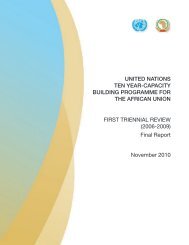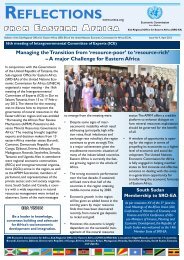Tool kit for Gender and Agriculture - Economic Commission for Africa
Tool kit for Gender and Agriculture - Economic Commission for Africa
Tool kit for Gender and Agriculture - Economic Commission for Africa
Create successful ePaper yourself
Turn your PDF publications into a flip-book with our unique Google optimized e-Paper software.
A. Purpose of <strong>Tool</strong><strong>kit</strong><br />
CHAPTER I: GENDER IN AGRICULTURE<br />
8<br />
<strong>Gender</strong> in <strong>Agriculture</strong><br />
This tool<strong>kit</strong> is designed to help Bank staff incorporate gender concerns into their agricultural<br />
sector work <strong>and</strong> the project cycle. Although no single strategy or package of<br />
interventions can cover the many different country situations that exist, the tool<strong>kit</strong><br />
demonstrates:<br />
• Why attention to gender is important<br />
• How such attention can be ensured.<br />
Development activities affect men <strong>and</strong> women differently; specific steps are<br />
often needed to make sure women are included <strong>and</strong> benefit in ef<strong>for</strong>ts to increase<br />
growth in the agriculture sector. Despite increased gender awareness, well-documented<br />
research findings, <strong>and</strong> the increasing availability of in<strong>for</strong>mation on women’s roles at<br />
the country level, attention to gender is not yet mainstreamed in ways that maximize<br />
the impact of policies <strong>and</strong> programs in the agriculture-related work in the Bank or borrower<br />
countries.<br />
The following sections describe why, based on key findings from research, attention<br />
to gender in agricultural sector <strong>and</strong> project work is necessary. Chapter II shows<br />
how to ensure attention to gender in the Bank’s lending <strong>and</strong> nonlending operations. Because<br />
the different steps of the project cycle are being revised in the different regions,<br />
the tool<strong>kit</strong> provides a basic, generic guide rather than a step-by-step approach geared to<br />
the project cycle. This chapter also distills lessons from project <strong>and</strong> sector work experience<br />
<strong>and</strong> draws examples of successful strategies, interventions, <strong>and</strong> promising approaches.<br />
Chapter III details the steps <strong>for</strong> including gender issues by agricultural subsectors.<br />
Chapter IV highlights some prominent agencies⎯international, bilateral, governmental,<br />
<strong>and</strong> nongovernmental⎯<strong>and</strong> Bank staff that constitute useful resources to<br />
which task managers can turn <strong>for</strong> expertise <strong>and</strong> advice on gender issues in agriculture.<br />
Chapter V presents samples of general terms of reference <strong>for</strong> gender experts hired at<br />
various stages of the project or business cycle. Task managers can adapt these to suit<br />
the particular country context in which they work. Because incorporating gender can<br />
entail costs <strong>for</strong> which funds have not been budgeted, Chapter VI lists additional financial<br />
resources that are available within the Bank <strong>for</strong> task managers to tap. For task<br />
managers who want to delve further into the subject, Chapter VII furnishes a list of<br />
useful publications, all of which are available in World Bank libraries. Appendix I to<br />
this tool<strong>kit</strong> contains a PowerPoint slide presentation giving an overview of gender issues<br />
in agriculture <strong>and</strong> outlining the main issues covered in this tool<strong>kit</strong>. Task managers<br />
can use this presentation to help build consensus <strong>for</strong> including gender in agricultural<br />
policy, programs, <strong>and</strong> projects. Appendix II includes the Bank’s operational directive<br />
4.20) on the gender dimension of development.<br />
B. What Is <strong>Gender</strong>?







